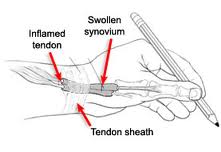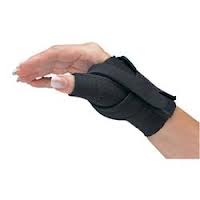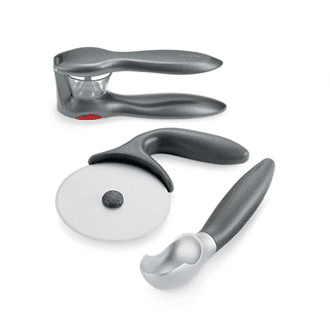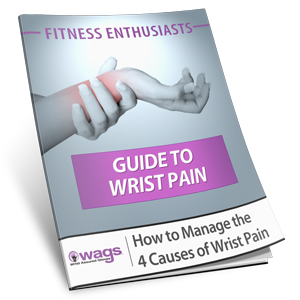3 TIPS FOR THUMB TENDINITIS
The most common site of source of pain in your thumb and wrist originates in the thumb pad where the metacarpal bone connects to the wrist at the trapezium carpal bone. The CMC joint or ‘basal thumb joint’ is a highly mobile, loose capsule joint. This mobility is essential for dexterity and the elaborate movements the thumb allows our hands to perform. But the constant use of our thumbs in our daily activities, along with the mobile structure of the joint makes the thumb susceptible to pain and injury. In fact, the CMC joint is often the first joint where osteoarthritis creeps in.
 Tendinitis of the thumb, a common source of pain, can be caused by the wrist and thumb movements used in your job, hobby, daily life & even repetitive micro-movements of excessive texting. When the tendons become swollen or irritated, the lining (synovium) around the tendon swells and the tendons don’t glide as they should. Officially referred to as Dequervain’s Syndrome, it is also known as ‘Mommy Thumb’ and occurs in a high rate of new mothers.
Tendinitis of the thumb, a common source of pain, can be caused by the wrist and thumb movements used in your job, hobby, daily life & even repetitive micro-movements of excessive texting. When the tendons become swollen or irritated, the lining (synovium) around the tendon swells and the tendons don’t glide as they should. Officially referred to as Dequervain’s Syndrome, it is also known as ‘Mommy Thumb’ and occurs in a high rate of new mothers.
Treat your Thumbs with Care
1. Rest & Ice: Ice the thumb and wrist area 5 – 15 minutes several times a day. Because up to 50% of the hand’s function relates to the thumb, it can be difficult to rest your thumbs. It’s important to increase your awareness of how you are using your thumbs & avoid the movements and activities that cause pain in your thumb pad and wrists.
2. Immobilize & Support the Thumb: A soft thumb & wrist support can serve as a visual reminder not to overuse your thumb, as well as providing some mild stability. But if you are unable to avoid using your thumb, especially against resistance (i.e. It’s unlikely a mom can go all day without picking up her baby), then a splint that immobilizes your wrist and thumb should be worn. Consult with a Certified Hand Therapist or Medical Specialist.
3. Modify Activities & Use Ergonomic Tools: Modification of your daily tasks will be necessary for healing and to prevent re-occurrence. Consciously avoiding activities that move the wrist side to side or cause thumb pain may require altering grasp patterns, using better lifting mechanics & form, reducing texting, using built up diameter pens and ergonomic kitchen and gardening tools. Check out our WAGs Ultra gloves to help with the discomfort associated with arthritic thumbs.









I need a glove that supports my arthritic thumbs during yoga mat activities
Pls recommend
Joan-
Thanks for your interest in WAGs. You’ll probably want either the Pro or the Ultra as they have a thicker gel pad.
The Ultra is a bit looser fit and is easier to put on and remove so is preferred by most people with arthritis.
We have a 30 day money back guarantee and during the time you can exchange for a different style or size or return the gloves
for a refund should they not provide relief for you.
Please let us know if we can be of further assistance,
Ursula
JPP Customer Service
info@getwags.com
800-606-4577
I am having the same problem at Yoga, with my thumb base hurting…. where can I get this glove? Does it allow one to do Yoga without the pain in the hand and base of thumb?
Joan…did the glove help your thumbs? Just beginning yoga and it’s very painful to weight bear at all on base of thumbs. I have pretty bad athritis there, especially in one thumb.
Pretty nice post. I juust stumbled upon your weblog and wished tto mention that I’ve truly loved browsing your blog posts.
After all I will be subscribing on your feed and I hoipe you write once more very soon!
Hello, I have osteoarthritis in my right CMC thumb joint. I miss doing yoga because I can’t bear my body weight on those thumbs that no longer flatten all the way.
Is the gel pad of the wags gloves in the “palm” of the hand to keep the Tender cmc joint up off of the mat? Allowing for body pressure to be on the palms instead? Thank you
Hi Leslie- Yes, the gel pad is wedge shaped which elevates the heel of your hand and wrist, so the CMC will be elevated too. Go ahead and give them a try, I think they’ll help you. Many of our customers have CMC arthritis, including me. I think they work, but if you don’t like them you can return in 30 days for a refund. Good Luck!
Hello,
I notice there are 2 gloves with wedges in them- I’d like to order a pair, does one of these pairs’ wedges not test under CMC joint- and u set the palm only? I don’t want to have the wedge under my tender CMC joint in a down dog yoga position.
Hi, The pad of our gloves does offer support for people with CMC arthritis. It elevates the wrist so you’re not bearing weight on a hard surface at CMC joint. You should get a pair and see if they work for you. I not we have a 30 day return policy. Good luck!
Hi, The pad of our gloves does offer support for people with CMC arthritis. It elevates the wrist so you’re not bearing weight on a hard surface at CMC joint. You should get a pair and see if they work for you. I not we have a 30 day return policy. Good luck!
Has anyone had successful basal thumb joint surgery? If so, could you share which surgeon you used and what type of surgery you had. There are many surgical options some with less recovery time; Dr. Ruch at Duke.
Lisa, I haven’t had any basal joint surgery. But if you look for an orthopedic surgeon who specializes in the hand that would be a good start, then you can speak to him or her about the different types of surgery and which one would be best for you. I wish you the best!